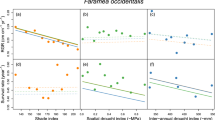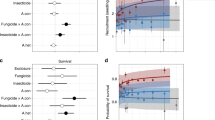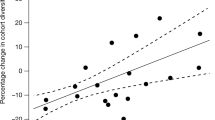Abstract
Competitive interactions between plants determine the success of individuals and species. In developing forests, competition for light is the predominant factor. Shade tolerators acclimate photosynthetically to low light1,2,3 and are capable of long-term survival under the shade cast by others, whereas shade avoiders rapidly dominate gaps but are overtaken in due course by shade-tolerant, later successional species. Shade avoidance4,5,6 results from the phytochrome-mediated perception of far-red radiation (700–800 nm) scattered from the leaves of neighbours, provides early warning of shading7, and induces developmental responses that, when successful, result in the overgrowth of those neighbours8. Shade tolerators cast a deep shade, whereas less-tolerant species cast light shade9, and saplings tend to have high survivorship in shade cast by conspecific adults, but high rates of mortality when shaded by more-tolerant species9. Here we report a parallel relationship in which the shade-avoidance responses of three tree species are inversely proportional to proximity signals generated by those species. On this basis, early successional species generate small proximity signals but react strongly to them, whereas late successional species react weakly but generate strong signals.
This is a preview of subscription content, access via your institution
Access options
Subscribe to this journal
Receive 51 print issues and online access
$199.00 per year
only $3.90 per issue
Buy this article
- Purchase on Springer Link
- Instant access to full article PDF
Prices may be subject to local taxes which are calculated during checkout




Similar content being viewed by others
References
Boardman, N. K. Comparative photosynthesis of sun and shade plants. Annu. Rev. Plant Physiol. 28, 355–377 (1977).
Bjørkman, O. in Encyclopaedia of Plant Physiology Vol. 12.4 (eds Lange O. L., Nobel, P. S., Osmond, C. B. & Ziegler, H.) 57–107 (Springer, Berlin, 1981).
Kull, O & Niinemets, U. Distribution of leaf photosynthetic properties in tree canopies: comparison of species with different shade tolerance. Funct. Ecol. 12, 472–479 (1998).
Smith, H. Light quality, photoperception and plant strategy. Annu. Rev. Plant Physiol. 33, 481–518 (1982).
Smith, H. Physiological and ecological function within the phytochrome family. Annu. Rev. Plant Physiol. Plant Mol. Biol. 46, 289–315 (1995).
Smith, H. Phytochromes and light signal perception by plants - an emerging synthesis. Nature 407, 585–591 (2000).
Ballare, C. L., Scopel, A. L. & Sanchez, R. A. Far-red radiation reflected from adjacent leaves: an early signal of competition in plant canopies. Science 247, 329–332 (1990).
Casal, J. J. & Smith, H. The function, action and adaptive significance of phytochrome in light-grown plants. Plant Cell Environ. 12, 855–862 (1989).
Canham, C. D., Finzi, A. C., Pacala, S. W. & Burbank, D. H. Causes and consequences of resource heterogeneity in forests - interspecific variation in light transmission by canopy trees. Can. J. Forest Res. 24, 337–349 (1994).
Smith, H. & Holmes, M. G. The function of phytochrome in the natural environment. III. Measurement and calculation of phytochrome photoequilibrium. Photochem. Photobiol. 25, 547–550 (1977).
Morgan, D. C. & Smith, H. Linear relationship between phytochrome photoequilibrium and growth in plants under simulated natural radiation. Nature 262, 210–212 (1976).
Gilbert, I. R., Seavers, G. P., Jarvis, P. G. & Smith, H. Photomorphogenesis and canopy dynamics. Phytochrome-mediated proximity perception accounts for the growth dynamics of canopies of Populus trichocarpa × deltoides ‘Beaupré’. Plant Cell Environ. 18, 475–449 (1995).
Morgan, D. C., Smith, H. A systematic relationship between phytochrome-controlled development and species habitat for plants grown in simulated natural radiation. Planta 145, 253–259 (1979).
Lei, T. T & Lechowicz, M. J. Diverse responses of maple saplings to forest light regimes. Am. J. Bot. 82, 9–19 (1998).
Child, R., Morgan, D. C. & Smith, H. Control of development in Chenopodium album by shadelight: The effect of light quality (red:far-red ratio) on morphogenesis. New Phytol. 89, 545–555 (1981).
Hayward, P. M. in Techniques in Photomorphogenesis (eds Smith, H. & Holmes, M. G.) 159–173 (Academic, London, 1984).
Acknowledgements
This research was funded by the Natural Environment Research Council, UK, and was made possible by the technical assistance of S. Smith, M. Pratt and G. Benskin.
Author information
Authors and Affiliations
Corresponding author
Rights and permissions
About this article
Cite this article
Gilbert, I., Jarvis, P. & Smith, H. Proximity signal and shade avoidance differences between early and late successional trees. Nature 411, 792–795 (2001). https://doi.org/10.1038/35081062
Received:
Accepted:
Issue Date:
DOI: https://doi.org/10.1038/35081062
This article is cited by
-
Plant behavior and coexistence: stem elongation of the carnivorous subshrub Drosophyllum lusitanicum within xerophytic shrub canopies
Plant Ecology (2021)
-
Far-red light acclimation in diverse oxygenic photosynthetic organisms
Photosynthesis Research (2019)
-
Light Restriction Delays Leaf Senescence in Winter Oilseed Rape (Brassica napus L.)
Journal of Plant Growth Regulation (2013)
-
The effect of age on height growth in even-sized saplings of Fagus sylvatica L.
Trees (2013)
-
Tree shape plasticity in relation to crown exposure
Trees (2012)
Comments
By submitting a comment you agree to abide by our Terms and Community Guidelines. If you find something abusive or that does not comply with our terms or guidelines please flag it as inappropriate.



